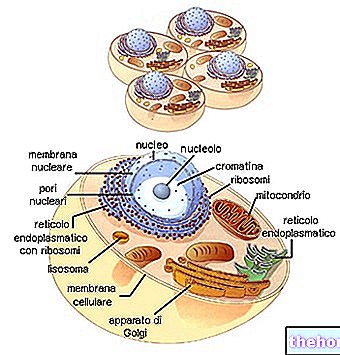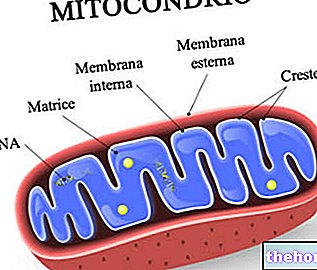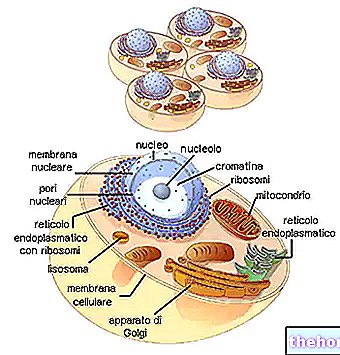- introduction -
The cell, together with the nucleus, is the fundamental unit of life and living systems grow by cell multiplication; it is the basis of every living organism, both animal and vegetable.
The organism, based on the number of cells of which it is composed, can be single-celled (bacterium, protozoa, amoeba, etc.), or multicellular (metazoans, metaphites, etc.). The cells have uniform morphological characters only in the lowest species, therefore in the simplest animals; in the others, between the different cells, differences in shape, size, relationships are established, following a process that leads to the formation of various organs with different functions: this process takes the name of morphological differentiation and functional.
The shape of the cell is linked to the state of aggregation and its function: we can thus have c. spheroidal, which are generally those found free in a liquid medium (white blood cells, egg cells); but most of the cells assume the most varied form following the mechanical thrusts and pressures of the contiguous cells: thus we have pyramid, cube, prism, polyhedron cells. The size is very variable, generally of a microscopic order; in humans, the smallest cells are the granules of the cerebellum (4-6 microns), the largest are the pyrenophores of some nerve cells (130 microns). We tried to establish whether the cell size depended on the somatic size of the " organism, that is, if the body volume was consequent to a greater number of cells or a greater size of the single ones. Following observations by Levi it was found that cells of the same type, in individuals of different size, have the same size, hence the important law of Driesch or constant cell size which states that not the size but mainly the number of cells affects the different body size.
CONSTITUTIVE AND ESSENTIAL PARTS OF THE CELL
Protoplasm is the main constituent of the cell and is divided into two parts: cytoplasm and nucleus. Between these two parts (that is, between the nuclear size and the total cellular size) there is a ratio called the nucleus-plasma index: it is obtained by dividing the volume of the nucleus by the volume of the cell, from which the previous one was subtracted, and it is expressed in cents. This index is very important because it can reveal metabolic and functional changes; for example, during growth the index tends to move in favor of the cytoplasm. In the latter, two constituents are always shown: one called the fundamental part, or hyaloplasm, and the other called chondrioma, consisting of small bodies in the shape of granules or filaments called mitochondria. : ergastoplasma, endoplasmic reticulum, Golgi apparatus, centriole apparatus and plasma membrane.

Click on the names of the various organelles to read the in-depth study
Image taken from www.progettogea.com
THE PROKARYOTS
Prokaryotes have a much simpler organization than eukaryotes: they lack organized nuclei included in a nuclear membrane; they have no complex chromosomes, endoplasmic reticulum and mitochondria. They also lack chloroplasts or plastids. Almost all prokaryotes have a rigid wall. mobile phone.
Hyprocaryotes are devoid of a primitive nucleus; in fact, they do not have a nucleus that can be isolated, but the "nuclear chromatin", that is, the nuclear DNA, in a single chromosome, ring-shaped, immersed in the cytoplasm. Prokaryotes are the point of origin for both the animal kingdom and the plant kingdom.
Prokaryotes can be divided into two basic classes: blue algae and bacteria (schizomycetes).
Present-day prokaryotes, represented by bacteria and blue algae, do not present particular differences from their fossil ancestors. Fossil bacterial cells differ from those of fossil algae in that unicellular algae, like their current descendants, were photosynthetic. In other words, they were able to synthesize nutrients with a high energy content, starting from simple elements (in this case carbon dioxide and water) using sunlight as an energy source.
The blue algae, having the structures and enzymes necessary for photosynthesis, are called autotrophic organisms (ie that feed on their own). Bacteria, on the other hand, are heterotrophic organisms, since they assimilate the nutrients necessary for their energy metabolism from the external environment.
One of the best known direct relationships of bacteria with man is that of intestinal bacterial flora, another is that of bacterial infectious diseases.
Prokaryotes date back to about four to five billion years ago and represent the primitive forms of life; with the passage of time we have come to the most complex organisms, up to man. Consequently, prokaryotes are the simplest and most ancient organisms.
During the evolution of the species, up to the higher forms, the primitive forms did not become extinct, but they too maintained a specific role in the vital balance. An example of this is the blue algae, which are still today among the major synthesizers of organic material in water (eg spirulina algae).
EUCARIOTS
Eukaryotes are characterized by the presence of specialized structures (organelles), absent in prokaryotes. The cells that make up the somatic tissues of plants and animals are all eukaryotic, as are those of many single-celled organisms.
UNICELLULAR AND MULTICELLULAR ORGANISMS
The main differences between prokaryotes and eukaryotes can be summarized as follows:
a) the former do not have a distinct nucleus, unlike eukaryotes, which, on the other hand, have an evident and well-defined nucleus.
b) prokaryotes are always unicellular organisms and, even in the event of an adhesion, the latter affects only the external envelope. Eukaryotes, on the other hand, are divided into unicellular and multicellular. Their multicellularity, however, begins with a "still primitive organization, as can be seen from the so-called cenobies; these, in fact, are nothing more than colonies of similar unicellular organisms, united among Each cell has a life of its own, which does not depend on the others, and the cenobium can survive serious accidents. larger than the others.
Unlike primitive unicellular and cenobic organisms, in which the cells are the same and have all functions, specific cells with a particular function appear in the Volvox. In fact we notice a flagellate part, suitable for movement, and a part composed of larger cells intended for reproduction. Ultimately, each cell tends to have its own structures called primary, fundamental for the life of the cell itself, and secondary (for specific tasks).
A unicellular organism has a moment of pause during reproduction, in which all its structures fulfill a single task; the cells that are produced will have to reconstitute normal specialization in order to survive. Any damage to their structures would mean death. Multicellular organisms, on the other hand, continue to live, being able to regenerate single cells.
Ultimately, it can be said that each cell has its own structure, which can be similar to the type structures, or it can move away from generality, lacking some cellular constituent.









.jpg)


















